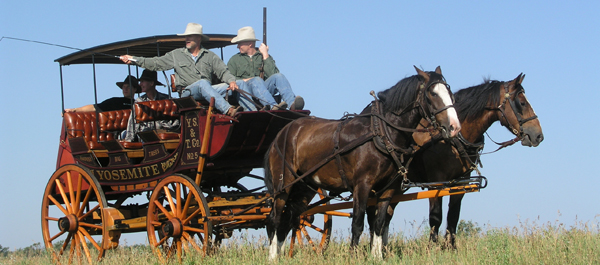
‘It’s more than a job….To have a part in helping secure so much history is a huge reward in itself’
The Historic Coach
In 1877, 13 years after President Abraham Lincoln ceded Yosemite to California as a state park, the Yosemite Stage and Turnpike Company began offering stagecoach tours to Mariposa Grove, the largest stand of giant sequoias in what became Yosemite National Park in 1890. The sequoias are much the same today, but most of the vintage touring coaches are gone. Restorers recently finished work on one of the company’s open-sided, horse-drawn models that belongs to the Madera County Historical Society. To get to the Big Trees by stage in the early days, drivers had to negotiate steep, narrow mountain roads with sheer drops and difficult switchbacks. On occasion, masked highwaymen interrupted these tour outings; during the first recorded robbery in 1883, passengers forked over $2,000 worth of cash and jewelry. Even without such “holdups,” the tour outings often took all day.
The Craftsmen
Doug Hansen and his craftsmen at the family-owned Hansen Wheel & Wagon Shop in Letcher, S.D., restored the 12-person (11 passengers and a driver) coach. They used a variety of woods, including yellow poplar, ash and oak. “It’s a wonderful piece of Americana,” says Hansen, who has seen a world of transportation history roll through his shop. “But, like so many other celebrated Western vehicles, over the years a number of its components were either lost, damaged or weakened. Throughout the restoration, our primary mission has been to maintain authenticity while also preserving the historic integrity of the piece.” Hansen adds: “It’s more than a job….To have a part in helping secure so much history is a huge reward in itself.”
The Restoration
Drawing on an impressive reference library of period photography, patterns and literature, not to mention decades of experience, Hansen’s team was able to reconstruct damaged and missing parts of the Yosemite coach. They painstakingly removed layers of paint to determine the original color scheme, striping and lettering styles and locations. One restorer found a small-caliber bullet lodged in a structural frame member—maybe fired by a road agent or perhaps by someone merely taking target practice. Taking into account the background research, vehicle documentation, disassembly, stripping, sanding, replacement of parts, rebuilding and reassembly, the coach endured more than 800 hours of reconstructive surgery—almost certainly more time than it took to build the vehicle in the late 1800s.




